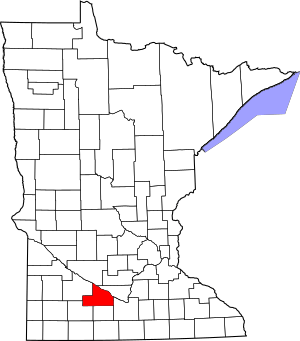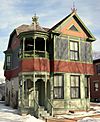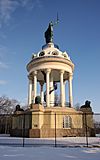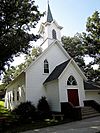National Register of Historic Places listings in Brown County, Minnesota facts for kids
This is a list of the National Register of Historic Places listings in Brown County, Minnesota. It is intended to be a complete list of the properties and districts on the National Register of Historic Places in Brown County, Minnesota, United States. The locations of National Register properties and districts for which the latitude and longitude coordinates are included below, may be seen in an online map.
There are 39 properties and districts listed on the National Register in the county. A supplementary list includes six additional sites that were formerly listed on the National Register.
Current listings
| Name on the Register | Image | Date listed | Location | City or town | Description | |
|---|---|---|---|---|---|---|
| 1 | Bendixon-Schmid House |
(#79001218) |
123 N. Marshall St. 44°14′27″N 94°58′32″W / 44.240833°N 94.975556°W |
Springfield | 1894 Queen Anne house representative of Springfield's enclave of large, professional-class homes, owned successively by two notable figures in the city's development as an early commercial center. | |
| 2 | C. Berg's Hotel |
(#11001084) |
145 W. Main St. 44°17′49″N 94°43′27″W / 44.296964°N 94.724033°W |
Sleepy Eye | 1899 hotel whose first-class accommodations, dining room, and display space for traveling salesmen were a key amenity in a regional milling and commerce center. | |
| 3 | Bjorneberg Garage |
(#79001197) |
Broadway St. 44°08′52″N 94°29′38″W / 44.147804°N 94.493904°W |
Hanska | Otherwise typical representative of the first automobile service stations—built c. 1919—made distinctive by its concrete bas-reliefs of motoring scenes. | |
| 4 | Boesch, Hummel, and Maltzahn Block |
(#79001201) |
6-12 N. Minnesota St. 44°18′49″N 94°27′33″W / 44.313725°N 94.459146°W |
New Ulm | Most elaborate intact example—built in 1890—of the Main Street commercial blocks constructed in area towns around the turn of the 20th century. Also a contributing property to the New Ulm Commercial Historic District. | |
| 5 | Chicago and North Western Depot |
(#92000822) |
Oak St., NW. 44°17′54″N 94°43′25″W / 44.298341°N 94.723523°W |
Sleepy Eye | Large 1902 railway station, a major component of Sleepy Eye's transportation infrastructure in the first half of the 20th century when the city was a key railroad center in Southern Minnesota. | |
| 6 | Chicago and North Western Railroad Depot |
(#79001202) |
S. Valley St. 44°18′47″N 94°27′13″W / 44.312981°N 94.453505°W |
New Ulm | c. 1895 stone railway depot. | |
| 7 | District No. 50 School |
(#100000564) |
20837 U.S. 14 44°19′33″N 94°35′24″W / 44.325897°N 94.590133°W |
Milford Township | Unusually intact 1912 one-room school built on a state-issued architectural plan. Also noted for representing efforts to provide nearby, locally-controlled education for rural Minnesota youth. Now the Milford Town Hall. | |
| 8 | Bernard Fesenmaier House |
(#79001203) |
426 N. State St. 44°19′01″N 94°27′58″W / 44.316807°N 94.466154°W |
New Ulm | One of the most intact examples of New Ulm's late-19th-century German-style houses, built c. 1888 with polychrome brick. | |
| 9 | Flandrau State Park CCC/WPA/Rustic Style Historic Resources |
(#89001658) |
Off County Highway 13 southeast of New Ulm 44°17′32″N 94°28′13″W / 44.292111°N 94.470221°W |
New Ulm | Park facilities with 24 contributing properties built 1934–42 with Germanic architectural elements, significant as examples of New Deal federal work relief, early Minnesota state park development, and National Park Service rustic design that uniquely harmonizes with local cultural context. | |
| 10 | Wanda Gág Childhood Home |
(#79001204) |
226 N. Washington St. 44°18′51″N 94°27′56″W / 44.3142°N 94.465622°W |
New Ulm | Home from birth to age 20 of artist and author Wanda Gág (1893–1946), whose 1928 children's book Millions of Cats helped establish the picture book format. Now a museum. | |
| 11 | Grand Hotel |
(#90000986) |
210 N. Minnesota St. 44°18′57″N 94°27′40″W / 44.315763°N 94.461034°W |
New Ulm | 1876 Italianate hotel expanded in 1899, a key amenity in New Ulm's economic development and its finest example of commercial Victorian architecture. Also a contributing property to the New Ulm Commercial Historic District. | |
| 12 | Hermann Monument |
(#73000965) |
Hermann Heights Park 44°18′26″N 94°28′22″W / 44.307098°N 94.472862°W |
New Ulm | Landmark 120-foot (37 m) monument built 1887–89 by the Sons of Hermann society to honor the nation's German American heritage. | |
| 13 | Frederick W. Kiesling House |
(#72000674) |
220 N. Minnesota St. 44°18′58″N 94°27′40″W / 44.316168°N 94.461113°W |
New Ulm | One of New Ulm's few remaining early houses—built in 1861—and a rare survivor of the Battles of New Ulm during the Dakota War of 1862. Also a contributing property to the New Ulm Commercial Historic District. | |
| 14 | Kreitinger Garage |
(#79001219) |
1 N. Cass St. 44°14′21″N 94°58′27″W / 44.239167°N 94.974167°W |
Springfield | c. 1911 car dealership with ornamental brickwork, a striking remnant of the early years of automobile use in Brown County. | |
| 15 | Lampert Lumber Company Line Yard |
(#79001196) |
Center St. 44°19′30″N 94°36′19″W / 44.325°N 94.605278°W |
Essig | Nominated as an extremely rare intact example of a small-town lumber store, built in 1919. Demolished except for an outlying shed. | |
| 16 | Liberal Union Hall |
(#79001198) |
Broadway and Main Sts. 44°08′56″N 94°29′38″W / 44.149009°N 94.493907°W |
Hanska | 1910 community center founded by the Unitarian separatists of the Nora Free Christian Church; noted as a long-serving local event venue and a symbol of a regionally unique religious group. | |
| 17 | Gov. John Lind House |
(#74001005) |
622 Center St. 44°18′45″N 94°27′43″W / 44.312363°N 94.46186°W |
New Ulm | 1887 Queen Anne house of populist politician John Lind (1854–1930), four-term congressman and 14th governor of Minnesota. | |
| 18 | Melges Bakery |
(#74001006) |
213 S. Minnesota St. 44°18′39″N 94°27′23″W / 44.310884°N 94.456435°W |
New Ulm | One of New Ulm's few intact 19th-century commercial buildings, an 1865 butcher shop converted and expanded into a bakery in 1871. | |
| 19 | New Ulm Armory |
(#79001205) |
205 N. Broadway St. 44°18′53″N 94°27′47″W / 44.314589°N 94.462981°W |
New Ulm | 1914 armory, leading example of the fortresslike style used in Minnesota before World War I, and home of one of the state's oldest National Guard companies, originating in 1871. | |
| 20 | New Ulm Commercial Historic District |
(#05001438) |
Roughly bounded by Minnesota St. between 1st St., S. and 3rd St., N. 44°18′51″N 94°27′36″W / 44.314299°N 94.459921°W |
New Ulm | 4-block downtown district important in the economic development of south-central Minnesota, with 64 contributing properties—including retail, bank, and service buildings, plus theatres, meeting halls, and government offices—mostly built between the 1880s and 1948. | |
| 21 | New Ulm High School |
(#15000438) |
1 N. State St. 44°18′44″N 94°27′46″W / 44.312222°N 94.462778°W |
New Ulm | 1915 school expanded in 1939 and 1956, reflecting the transformation of public high school education from the Progressive Era of the original section to the federal work relief of the 1930s and the Post–World War II baby boom. Later used as the New Ulm Junior High School. | |
| 22 | New Ulm Oil Company Service Station |
(#79001206) |
Broadway and Fifth Streets 44°19′04″N 94°27′54″W / 44.317808°N 94.464927°W |
New Ulm | Fanciful 1926 gas station flanked by two towers, a rare surviving example of the eyecatching custom designs built throughout southern Minnesota by a local company as automobile use expanded in the 1920s. | |
| 23 | New Ulm Post Office |
(#70000287) |
Center St. and Broadway 44°18′47″N 94°27′37″W / 44.312979°N 94.460275°W |
New Ulm | Striking 1909 Renaissance Revival post office designed to reflect the heritage of New Ulm's original Germanic settlers. Also a contributing property to the New Ulm Commercial Historic District. Now houses the Brown County Historical Society. | |
| 24 | Nora Free Christian Church |
(#88001176) |
Minnesota Highway 257 44°08′35″N 94°28′53″W / 44.143163°N 94.481353°W |
Hanska | 1883 church, 1906 parsonage, and cemetery associated with Norwegian intellectual Kristofer Janson (1841–1917) and his protégé Amandus Norman, who founded a liberal Unitarian minority among the state's conservative Lutheran Norwegian immigrants. | |
| 25 | Adolph C. Ochs House |
(#79001220) |
303 N. Marshall St. 44°14′32″N 94°58′33″W / 44.242305°N 94.975696°W |
Springfield | 1911 Colonial Revival house of the founder of the A.C. Ochs Brick and Tile Company, a major local industry. | |
| 26 | Old Main, Dr. Martin Luther College |
(#79001208) |
College Heights, Martin Luther College campus 44°18′21″N 94°28′16″W / 44.305756°N 94.471175°W |
New Ulm | 1884 original building of a Lutheran college; a leading example of Gothic Revival architecture in Minnesota and a distinctive symbol of local religious education. | |
| 27 | August Schell Brewing Company |
(#74001007) |
20th South St. 44°17′21″N 94°26′59″W / 44.289233°N 94.449683°W |
New Ulm | Only surviving example of New Ulm's seven early breweries—established in 1860—with highly intact industrial buildings, residences, and gardens. | |
| 28 | Otto Schell House |
(#79001210) |
Point Lookout 44°17′29″N 94°26′49″W / 44.291493°N 94.447076°W |
New Ulm | c. 1895 house of the second-generation manager of the August Schell Brewing Company, significant for its well-preserved Queen Anne architecture and association with an important local business. | |
| 29 | Shady Lane Stock Farm |
(#79001221) |
U.S. Route 14 44°15′04″N 94°56′48″W / 44.251°N 94.9466°W |
Springfield | Farm with four structures built 1898–1913, significant for its regional influence in progressive farming (especially stock breeding), owner LaForest E. Potter's extensive agricultural association activity, and its prototype of the brick "A.C.O." silos erected throughout the Midwest. | |
| 30 | Sleepy Eye Milling Company |
(#91000038) |
Junction of 4th and Oak Sts., NE. 44°17′55″N 94°43′06″W / 44.29866°N 94.718263°W |
Sleepy Eye | Flour milling complex with 20 contributing properties built 1901–1921, southern Minnesota's most complete example of an important agricultural processing industry. | |
| 31 | W. W. Smith House |
(#79001211) |
101 Linden St., SW. 44°17′34″N 94°43′24″W / 44.292841°N 94.723219°W |
Sleepy Eye | c. 1901 house, Sleepy Eye's best-preserved example of the large residences erected by its professional class at the turn of the 20th century. Now a bed and breakfast. | |
| 32 | South Broadway Historic District |
(#79001212) |
200–308 S. Broadway 44°18′39″N 94°27′33″W / 44.310833°N 94.459167°W |
New Ulm | Locally distinctive row of eight brick houses constructed 1895–1906, and associated with a cross-section of New Ulm's professional class at the turn of the 20th century. | |
| 33 | South German Street Historic District |
(#79001217) |
110–312 S. German St. 44°18′43″N 94°27′21″W / 44.311889°N 94.455798°W |
New Ulm | Eight houses mostly built 1884–1899, significant as Southwest Minnesota's best collection of large, late-19th-century residences and for their association with the era's business leaders in New Ulm. | |
| 34 | St. Michael's School and Convent |
(#79001213) |
500 N. State St. 44°19′02″N 94°27′59″W / 44.317093°N 94.466516°W |
New Ulm | 1872 Italianate parochial building with a slightly later Second Empire height addition and 1898 Gothic Revival chapel, a rare example of early institutional architecture in Brown County. | |
| 35 | Synsteby Site |
(#75000976) |
Address Restricted 44°06′59″N 94°32′53″W / 44.116388°N 94.548045°W |
Hanska | Archaeological site unique in Minnesota for exhibiting four distinct cultural components: two separate Woodland period occupations, a Mississippian culture phase, and an 1863 Euro-American fort. Now preserved within Lake Hanska County Park. | |
| 36 | Thormodson Barn |
(#79001199) |
Off Minnesota Highway 257 44°07′50″N 94°26′27″W / 44.13064°N 94.440901°W |
Hanska | 1912 hexadecagonal barn, Brown County's only known example of the round barn fad and one of the few in southwestern Minnesota. | |
| 37 | Turner Hall |
(#79001215) |
State and 1st South Sts. 44°18′37″N 94°27′39″W / 44.310328°N 94.460798°W |
New Ulm | 1873 meeting hall, icon of New Ulm's German heritage. | |
| 38 | Winona and St. Peter Freight Depot |
(#79001216) |
Oak St., NE. 44°17′55″N 94°43′17″W / 44.298619°N 94.721519°W |
Sleepy Eye | c. 1887 Winona and St. Peter Railroad depot, oldest surviving building associated with the transformative first years of rail access in Brown County. |
Former listings
| Name on the Register | Image | Date listed | Date removed | Location | City or town | Summary | |
|---|---|---|---|---|---|---|---|
| 1 | Chicago and North Western Section House |
(#79001195) |
|
Railroad and Brown Sts. (original address) Current coordinates are 44°04′29″N 95°39′54″W / 44.074602°N 95.665061°W |
Comfrey | c. 1899 section house, nominated as Brown County's last remaining structure associated with its later granger rail lines. Moved to End-O-Line Railroad Park in Currie, Minnesota in 1988. | |
| 2 | Cobden Jail |
(#79001194) |
|
2nd Street 44°17′11″N 94°51′01″W / 44.286392°N 94.850375°W |
Cobden | Built c. 1900. Significantly altered in 1989. | |
| 3 | New Ulm Roller Mill Complex |
(#79001207) |
|
222 1st South St. |
New Ulm | Flour mill complex dating to 1910. Burned down in the early 1980s. | |
| 4 | Ruemke Mercantile Store |
(#79001209) |
|
226 N. Minnesota |
New Ulm | 1895 Queen Anne commercial building. Demolished in 1981. | |
| 5 | Tivoli Gardens |
(#79001214) |
|
313 1st North St. |
New Ulm | 1885 restaurant. Demolished in 1985. | |
| 6 | Twente Farm Elevator and Granary |
(#79001200) |
|
off Co. Rd. 16 |
Albin Township | 1885 agricultural buildings. Demolished in 1986. |

All content from Kiddle encyclopedia articles (including the article images and facts) can be freely used under Attribution-ShareAlike license, unless stated otherwise. Cite this article:
National Register of Historic Places listings in Brown County, Minnesota Facts for Kids. Kiddle Encyclopedia.








































